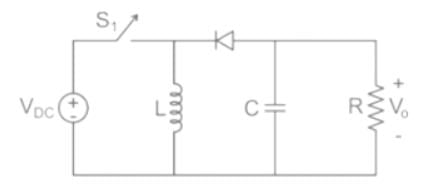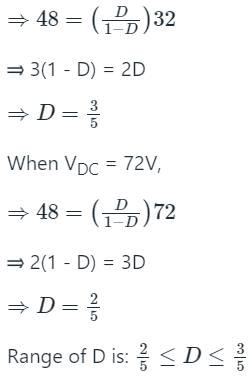Electrical Engineering (EE) Exam > Electrical Engineering (EE) Questions > The input voltage VDCof the buck-boost conver...
Start Learning for Free
The input voltage VDC of the buck-boost converter shown below varies from 32 V to 72 V. Assume that all components are ideal, inductor current is continuous, and output voltage is ripple free. The range of duty ratio D of the converter for which the magnitude of the steady-state output voltage remains constant at 48 V is


- a)

- b)

- c)0 ≤ D ≤ 1
- d)

Correct answer is option 'A'. Can you explain this answer?
Verified Answer
The input voltage VDCof the buck-boost converter shown below varies fr...
Concept:
For a buck-boost converter,

Calculation:
Given that,
Source voltage (VDC) = 32 V to 72 V
Output voltage, (V0) = 48 V
For a buck-boost converter,

Where D is duty ratio
When VDC = 32V,


|
Explore Courses for Electrical Engineering (EE) exam
|

|
Question Description
The input voltage VDCof the buck-boost converter shown below varies from 32 V to 72 V. Assume that all components are ideal, inductor current is continuous, and output voltage is ripple free. The range of duty ratio D of the converter for which the magnitude of the steady-state output voltage remains constant at 48 V isa)b)c)0 ≤ D ≤ 1d)Correct answer is option 'A'. Can you explain this answer? for Electrical Engineering (EE) 2025 is part of Electrical Engineering (EE) preparation. The Question and answers have been prepared according to the Electrical Engineering (EE) exam syllabus. Information about The input voltage VDCof the buck-boost converter shown below varies from 32 V to 72 V. Assume that all components are ideal, inductor current is continuous, and output voltage is ripple free. The range of duty ratio D of the converter for which the magnitude of the steady-state output voltage remains constant at 48 V isa)b)c)0 ≤ D ≤ 1d)Correct answer is option 'A'. Can you explain this answer? covers all topics & solutions for Electrical Engineering (EE) 2025 Exam. Find important definitions, questions, meanings, examples, exercises and tests below for The input voltage VDCof the buck-boost converter shown below varies from 32 V to 72 V. Assume that all components are ideal, inductor current is continuous, and output voltage is ripple free. The range of duty ratio D of the converter for which the magnitude of the steady-state output voltage remains constant at 48 V isa)b)c)0 ≤ D ≤ 1d)Correct answer is option 'A'. Can you explain this answer?.
The input voltage VDCof the buck-boost converter shown below varies from 32 V to 72 V. Assume that all components are ideal, inductor current is continuous, and output voltage is ripple free. The range of duty ratio D of the converter for which the magnitude of the steady-state output voltage remains constant at 48 V isa)b)c)0 ≤ D ≤ 1d)Correct answer is option 'A'. Can you explain this answer? for Electrical Engineering (EE) 2025 is part of Electrical Engineering (EE) preparation. The Question and answers have been prepared according to the Electrical Engineering (EE) exam syllabus. Information about The input voltage VDCof the buck-boost converter shown below varies from 32 V to 72 V. Assume that all components are ideal, inductor current is continuous, and output voltage is ripple free. The range of duty ratio D of the converter for which the magnitude of the steady-state output voltage remains constant at 48 V isa)b)c)0 ≤ D ≤ 1d)Correct answer is option 'A'. Can you explain this answer? covers all topics & solutions for Electrical Engineering (EE) 2025 Exam. Find important definitions, questions, meanings, examples, exercises and tests below for The input voltage VDCof the buck-boost converter shown below varies from 32 V to 72 V. Assume that all components are ideal, inductor current is continuous, and output voltage is ripple free. The range of duty ratio D of the converter for which the magnitude of the steady-state output voltage remains constant at 48 V isa)b)c)0 ≤ D ≤ 1d)Correct answer is option 'A'. Can you explain this answer?.
Solutions for The input voltage VDCof the buck-boost converter shown below varies from 32 V to 72 V. Assume that all components are ideal, inductor current is continuous, and output voltage is ripple free. The range of duty ratio D of the converter for which the magnitude of the steady-state output voltage remains constant at 48 V isa)b)c)0 ≤ D ≤ 1d)Correct answer is option 'A'. Can you explain this answer? in English & in Hindi are available as part of our courses for Electrical Engineering (EE).
Download more important topics, notes, lectures and mock test series for Electrical Engineering (EE) Exam by signing up for free.
Here you can find the meaning of The input voltage VDCof the buck-boost converter shown below varies from 32 V to 72 V. Assume that all components are ideal, inductor current is continuous, and output voltage is ripple free. The range of duty ratio D of the converter for which the magnitude of the steady-state output voltage remains constant at 48 V isa)b)c)0 ≤ D ≤ 1d)Correct answer is option 'A'. Can you explain this answer? defined & explained in the simplest way possible. Besides giving the explanation of
The input voltage VDCof the buck-boost converter shown below varies from 32 V to 72 V. Assume that all components are ideal, inductor current is continuous, and output voltage is ripple free. The range of duty ratio D of the converter for which the magnitude of the steady-state output voltage remains constant at 48 V isa)b)c)0 ≤ D ≤ 1d)Correct answer is option 'A'. Can you explain this answer?, a detailed solution for The input voltage VDCof the buck-boost converter shown below varies from 32 V to 72 V. Assume that all components are ideal, inductor current is continuous, and output voltage is ripple free. The range of duty ratio D of the converter for which the magnitude of the steady-state output voltage remains constant at 48 V isa)b)c)0 ≤ D ≤ 1d)Correct answer is option 'A'. Can you explain this answer? has been provided alongside types of The input voltage VDCof the buck-boost converter shown below varies from 32 V to 72 V. Assume that all components are ideal, inductor current is continuous, and output voltage is ripple free. The range of duty ratio D of the converter for which the magnitude of the steady-state output voltage remains constant at 48 V isa)b)c)0 ≤ D ≤ 1d)Correct answer is option 'A'. Can you explain this answer? theory, EduRev gives you an
ample number of questions to practice The input voltage VDCof the buck-boost converter shown below varies from 32 V to 72 V. Assume that all components are ideal, inductor current is continuous, and output voltage is ripple free. The range of duty ratio D of the converter for which the magnitude of the steady-state output voltage remains constant at 48 V isa)b)c)0 ≤ D ≤ 1d)Correct answer is option 'A'. Can you explain this answer? tests, examples and also practice Electrical Engineering (EE) tests.

|
Explore Courses for Electrical Engineering (EE) exam
|

|
Signup for Free!
Signup to see your scores go up within 7 days! Learn & Practice with 1000+ FREE Notes, Videos & Tests.


















